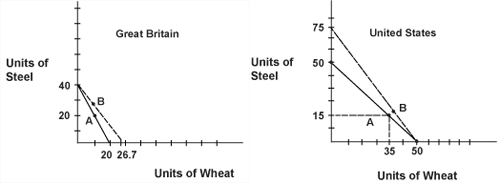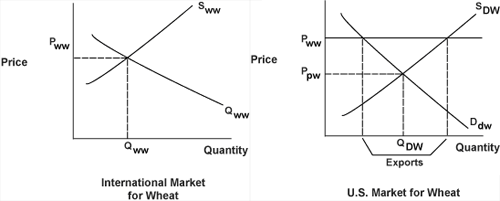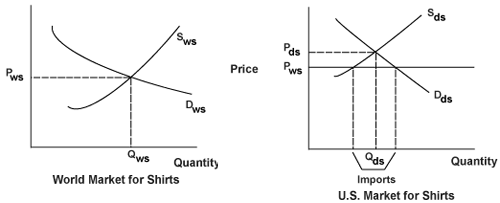The next question to determine is what the terms of trade would be. Clearly the U.S. Great Britain Great Britain offered five units of wheat for each five units of U.S. U.S.
The actual terms of trade will depend on overall world and supply conditions, within the limits just mentioned. However, trade will not occur unless the trade is mutually beneficial.
The actual terms of trade will depend on overall world and supply conditions, within the limits just mentioned. However, trade will not occur unless the trade is mutually beneficial.
Suppose the terms of trade settle at 1.5 units of steel per unit of wheat. We can graph a trading possibilities curve and relate that curve to the original production possibilities curve.
Figure 5.2: Trading Possibilities Curve
 |
The slope of the trading possibilities curve will be -1.5 for each country. The original production possibilities curve is shifted to the trading possibilities curve by specializing in the production of the good for which each country has a comparative advantage and by then engaging in international trade. As the possible amount of consumption increases for both countries, they will each enjoy a higher standard of living.
Recall that we assume that without trade, the
Note that the above analysis assumes that relative production costs are constant, which allows for straight lines to be used as a production possibilities curve. In reality, as more and more of a good is produced, relative production costs increase because less efficient resources will be used as production increases. As a result, we expect that production possibility curves will be curved lines. Therefore, specialization will not be an all-or-nothing type of situation. Even if the
Domestic producers of goods that are produced relatively cheaply will be able to get higher prices in the world market. Suppose the
Figure 5.3: Effects of International Trade on Domestic Supply and Demand
 |
However, for goods produced relatively inefficiently by the U.S.
Figure 5.4: Effects of International Trade on Domestic Supply and Demand
Figure 5.4: Effects of International Trade on Domestic Supply and Demand
 |






0 comments:
Post a Comment